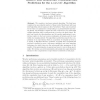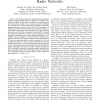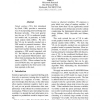181 search results - page 26 / 37 » Learning bayesian networks consistent with the optimal branc... |
ALT
2004
Springer
14 years 4 months ago
2004
Springer
We consider a two-layer network algorithm. The first layer consists of an uncountable number of linear units. Each linear unit is an LMS algorithm whose inputs are first “kerne...
INFOCOM
2012
IEEE
11 years 9 months ago
2012
IEEE
—Market based spectrum trading has been extensively studied to realize efficient spectrum utilization in cognitive radio networks (CRNs). In this paper, we utilize the concept o...
IJCNN
2007
IEEE
14 years 1 months ago
2007
IEEE
— Fuzzy Cognitive Maps (FCMs) are a class of discrete-time Artificial Neural Networks that are used to model dynamic systems. A recently introduced supervised learning method, wh...
EUROPAR
2006
Springer
13 years 11 months ago
2006
Springer
Next location prediction anticipates a person's movement based on the history of previous sojourns. It is useful for proactive actions taken to assist the person in an ubiquit...
EMNLP
2009
13 years 5 months ago
2009
Virtual evidence (VE), first introduced by (Pearl, 1988), provides a convenient way of incorporating prior knowledge into Bayesian networks. This work generalizes the use of VE to...



